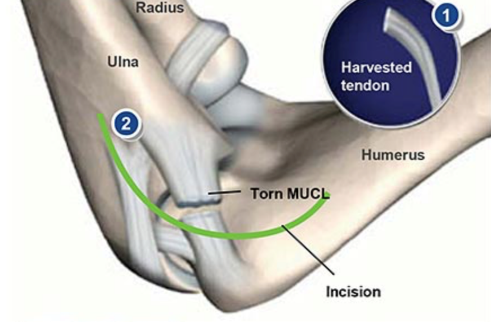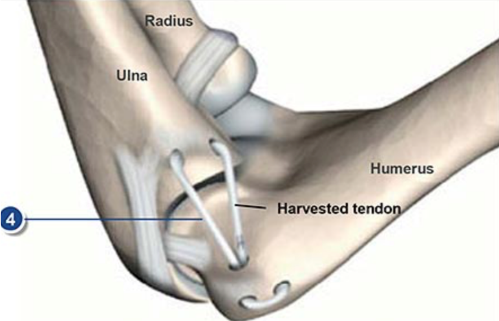MCL Repair Surgery (Tommy John Procedure)
Your Diagnosis
Medial Collateral Ligament (MCL) reconstruction surgery, or the Tommy John Procedure is done to help people with a torn medial collateral ligament of the elbow. See the MCL Injury section.
What happens during Surgery?
Surgery takes 1 to 2 hours. It is done with general anesthesia meaning the person is asleep. Usually, the person will have a nerve block placed in their neck which makes their shoulder and arm numb for 6 to 48 hours. During surgery a tendon from the forearm will be taken (or a cadaver tendon is used) and used to reconstruct the MCL through a 4 inch cut on the inside of the elbow. The tendon will be weaved into the bones on both sides of the elbow joint to produce a new ligament. The old ligament will be repaired for further strengthening.
Immediately after Surgery
The person will wake from surgery in the recovery room where they will spend 1 to 3 hours. Most people will then be allowed to go home when they are awake enough. The person will go home in a sling. The person cannot drive or take public transportation home. They must have a ride.
A person may have questions following your surgery. Many of these frequently asked questions surgery questions can be answered here.
Therapy after Surgery
After MCL reconstruction surgery, the person will be given restrictions. At their first post-operative appointment, the person will be placed in a hinged elbow brace, which they will wear full time for 6 weeks, even while sleeping. During this time, the person will be under the guidance of their provider, and the brace will be adjusted so that the person will have more and more range-of-motion over time. Formal therapy is usually begun early to work on range-of-motion. After 6 weeks the brace is removed and more Elbow Stretching is required. Also, a light weight, high repetition strengthening program is started.
What to expect after Surgery: week 0 through week 6 (Phase One)
- Pain: Right after surgery, the elbow will hurt. Pain is expected. The person will be given pain medications to go home with. The pain medications will help with the pain but will not remove the pain. By day 5 after surgery almost all people have stopped taking the pain medication. It is important to stop taking the pain medications because pain at the repair site is protective. People who continue to take the pain medications have a much greater chance of the surgery not working.
- Therapy: Therapy for elbow range-of-motion is usually started right away.
- Precautions: The person is placed in a locked-elbow-immobilizer with the elbow/arm at 90 degrees, but allowing full flexion. The elbow is kept at 90 degrees for 2 weeks. After 2 weeks the elbow range-of-motion is checked. If the elbow is stiff and doesn’t move much then the range-of-motion allowed by the brace is increased. If the elbow is loose and moves a lot then the brace is kept at 90 degrees. This happens every week until the 6 week mark.
- Work: If a person returns to work they must follow the above precautions.
What to expect after Surgery: week 6 through week 12 (Phase Two)
- Pain: Most people have mild pain at this point.
- Therapy: At this point a lightweight, high repetition strengthening therapy program will start. Range-of-motion therapy is sometimes still needed beyond 6 weeks.
- Precautions: The locked-elbow-immobilizer is removed. The person will be allowed to start using their elbow for normal daily activities such as opening a car door, driving, opening the refrigerator, lifting a box, etc. Heavy lifting should be avoided. Throwing should be avoided.
- Work: Most people with desk jobs have returned to work. Those with manual labor jobs usually cannot return to work until after the arm has been strengthened.
What to expect after Surgery: week 12 through 1 year and beyond (Phase Three)
- Pain: Most people have minimal to no pain.
- Therapy: When the person has full range-of-motion and normal strength (equal to that of the other arm and equal to their strength before surgery) then a Throw Hardening Program is begun. In this program the person will begin throwing a ball short distances and progress over an 8 month period to throwing with full power and speed. This program is usually begun 3 to 4 months after surgery.
- Precautions: Other than the throwing precautions mentioned above, usually there are no precautions by week 12.
- Work: Most people (even manual laborers) have returned to work.
Return to Sports
Following a Tommy John surgery and the intense therapy described above, most people will return to sports by 1 year. Baseball pitchers sometimes take longer given the throwing burden the elbow experiences. Catchers and other positions that do not require as much throwing can sometimes return as soon as 8 months.


Torn MCL/MUCL

Preparing the bone for reconstruction of MCL
